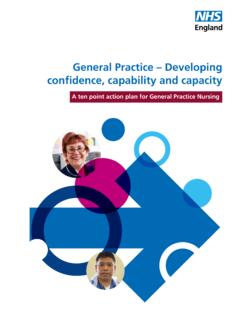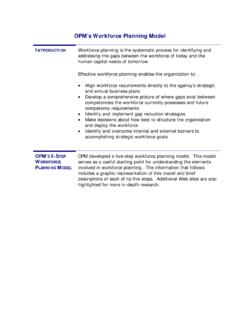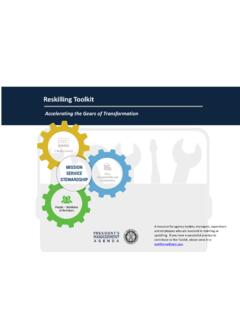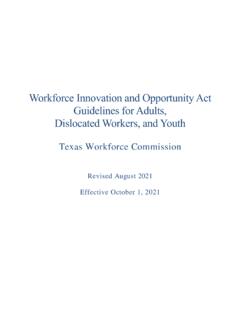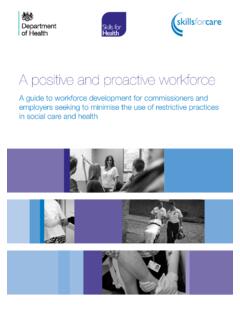Transcription of Clinical Workforce Report - GOV.UK
1 Evidence from NHS Improvement on Clinical staff shortages A Workforce analysis February 2016 2 About NHS Improvement NHS Improvement is responsible for overseeing foundation trusts, NHS trusts and independent providers. We offer the active support these frontline providers need to give patients consistently safe, high quality, compassionate care within local health systems that are financially sustainable. By holding providers to account and, where necessary, intervening, we help the NHS to meet its short-term challenges and secure its future. NHS Improvement brings together Monitor, the NHS Trust Development Authority plus groups from three other organisations: from NHS England both the Patient Safety Team and the Advancing Change Team, from NHS Interim Management and Support two Intensive Support Teams, together with the National Reporting and Learning System.
2 NHS Improvement is an operational name for the organisation which formally comes into being from 1 April 2016. 3 Contents Summary .. 4 1. Background .. 6 2. What has happened to the nursing Workforce ? .. 6 Nursing demand has risen rapidly and is outstripping supply .. 6 Nurse demand has risen partly because of increasing activity, but also as a result of safe staffing .. 9 Providers have responded to the supply shortage in large measure by hiring agency workers, driving up agency costs .. 14 Improvements in providers productivity have moderated the additional demand for nurses and the increase in agency spend .. 14 3. What has happened to the consultant Workforce ? .. 15 The number of consultants has increased faster than activity .. 15 Demand is outstripping supply in some key specialties .. 16 4. NHS Improvement s plan to help providers respond to Workforce shortages.
3 17 Supporting local action by providers .. 18 National actions to support local responses .. 19 4 Summary1 1. There has been a rapid rise in demand for hospital nurses since publication of the Francis Report in February 2013 and the push for higher staffing levels that followed. For example, hospitals demand for nurses caring for adult acute patients in 2014 was 189,000, around 7,000 more than hospitals had been forecasting just a year earlier and 24,000 more than was forecast two years before. Taken together, trusts current forecasts anticipate further growth in the nursing Workforce . 2. Rapid growth in the number of nurses employed over the last two-and-a-half years has resulted in an increase in the ratio of nurses to patients in hospitals. However, the recent increase has only returned this ratio to where it stood at the end of 2011 (see figure below).
4 Trends in nurse-to-patient ratio, admissions and length of stay 2010 to 20152 3. The supply of nurses has failed to keep up with this rapid growth in demand. Hospitals estimate they are 15,000 nurses3 short of what they need. A significant element of this supply shortfall can be ascribed to the collapse in the number of nurses from outside the European Economic Area joining the NHS 1 Analysis correct as at October 2015. 2 Substantive nurses only. 3 Nurses trained to care for adults and working in both the acute and the community sectors. 5 each year. This figure has fallen by over 95% from its peak of more than 15,000 in the early 2000s. 4. Inevitably, this significant supply shortfall has driven up the cost of agency nurses. Agency charges for nurses increased by around 30% from 2012 to 2015. 5. Nevertheless, the nurse shortfall would be even worse were it not for productivity improvements made by trusts over the last two years.
5 In particular, reductions in average length of stay have offset a sharp increase in hospital admissions (see figure above). Without this improvement, there would likely be a need for around 5,000 extra nurses at a cost to the NHS of about 250 million at agency 6. We are supporting local Workforce initiatives and working with system partners to rebalance supply and demand at the national level. Our actions include: supporting providers on Workforce planning and improving co-ordination at a national level building on the work of the Carter Review to improve provider productivity reducing providers agency costs. 4 Our calculation is based on NHS Professionals observed rate for a band 5 nurse in 2014/15. 6 1. Background The NHS as a whole directly employs over 640,000 people in the professionally qualified Clinical Workforce , including 110,000 doctors and over 315,000 Spending on total Workforce represents an estimated 70% of a typical hospital s6 costs, with much of this spent on the Clinical The right Workforce is crucial to ensuring the quality of care that hospitals provide.
6 It is also central to making the productivity and efficiency gains needed to meet their financial challenges, and transforming services through new care models. Growing shortages of qualified Clinical staff have led providers to make increasing use of agency and other temporary workers to fill vacancies. We have recently introduced new rules on agency workers to help providers address the impact of this trend on their costs. This Report sets out our analysis of the causes and extent of current Clinical staff shortages in acute hospitals, focusing on adult nurses8 and Its aims are to provide evidence informing decisions about the sector at a national level,10 and to highlight some of the materials we are developing to support providers. Further, the Report sets out the actions we will take at a national level with our system partners to support providers facing Workforce shortages.
7 2. What has happened to the nursing Workforce ? Nursing demand has risen rapidly and is outstripping supply Since the end of 2012, there has been a large increase in demand for hospital nurses across the NHS. In 2014, providers reported to Health Education England (HEE)11 that they needed 189,000 adult nurses12 (acute) in total, yet two years earlier they predicted they would need only 165,000; in 2013, this had risen to over 180,000 (see Figure 2). 5 Health and Social Care Information Centre NHS Workforce statistics June 2015, provisional statistics. 6 7 According to NHS Employers, of NHS employees are professionally qualified Clinical staff 8 Adult nurses in our analysis refers collectively to all nurses caring for adult acute, elderly and adult general patients. 9 Other areas and specialties, such as general practice, may also be experiencing shortages but are outside the scope of this study.
8 10 Analysis correct as at October 2015. 11 HEE asks providers for their forecast Workforce demand each year. 12 HEE defines adult nurses differently from us as it bases its definition on training branches. Where we cite HEE adult nursing data, we indicate whether the data are for nurses working in the adult acute and/or community sector. 7 This rise in demand is reflected in the increasing numbers of nurses employed. Between October 2012 and April 2015 the number of adult nurses employed grew by 10,000 full-time equivalents (FTEs) or (see Figure 1). However, demand still exceeds supply. HEE s data indicate that providers had 15,489 FTE vacancies for adult nurses (both those working in the acute and the community sector) in April 2014, equivalent to a vacancy At that time, trusts also indicated to HEE that they expected to need a further 6,389 nurses in 2014 Figure 1: Qualified adult nurses employed in the NHS Figure 2: Numbers employed and forecast demand for adult nurses (FTE) working in the acute sector Source: HSCIC Source: HEE One factor contributing to continuing high vacancy levels is the drop in recruitment of nurses from outside the European Economic Area (EEA).
9 International recruitment has historically helped fill gaps between predicted and actual demand for nurses, and since 2009 the number of nurses coming to the UK from the EEA has increased. However, the number of nurses who join the UK nursing register from outside the EEA has declined substantially. As shown in Figure 3, in the early 2000s, 12,000 to 15,000 non-EEA nurses joined the UK nursing register each year. From 2008/09 to 2014/15 this number fell to around 1,000 nurses a year, and in 2014/15 only 665 non-EEA nurses were registered. 13 HEE Workforce plan for England 2015/16 note that the vacancy figure is as at 1 April 2014. 14 Overall requirements are predicted to increase by 5,642 FTE in 2019. Increases in 2014/15 are predicted to be followed by reductions between 2015 and 2019. HEE Workforce plan for England 2015/16.
10 8 Figure 3: New registrations on the Nursing and Midwifery Council register according to EEA and non-EEA origin Source: RCN (2015) International recruitment 2015 More generally, the supply of UK-trained nursing staff is slow to respond to demand changes. In the NHS, as in many other health systems,15 the future supply of nurses is planned centrally. Training a nurse takes more than three years. So when demand rises considerably and rapidly, the supply of trained nurses available to fill hospitals substantive (ie permanent) nursing posts cannot easily respond at the same pace. The increase in demand has also come at a time when fewer nurses are qualifying between 2010/11 and 2012/13 the number of nursing training places fell by from 20,092 to 17, Return-to-practice schemes are another means of expanding supply. The centrally funded return-to-practice initiative between February 1999 and March 2004 resulted in 18,500 former nurses and midwives returning to work in the However, recent schemes have not had the same level of success around 1,300 nurses signed up to HEE s most recent scheme.










